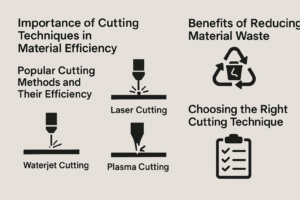Table of Contents:
- Introduction: Importance of Cutting Techniques in Material Efficiency
- Popular Cutting Methods and Their Efficiency
- Laser Cutting
- Waterjet Cutting
- Plasma Cutting
- Benefits of Reducing Material Waste
- Real-World Examples
- Choosing the Right Cutting Technique
- Conclusion: Achieving Efficiency and Sustainability
Introduction: Importance of Cutting Techniques in Material Efficiency
Reducing material waste is not just an economic benefit but a critical step toward sustainability in manufacturing. Choosing the right metal-cutting technique minimizes waste and improves efficiency. Companies like Bluegrass Bit offer advanced metal-cutting services emphasizing precision and minimal waste. With resources becoming scarcer and environmental regulations tightening, using the most effective cutting techniques has never been more essential.

Every metal fabrication industry must consider how its cutting methods impact the bottom line and the environment. Effectively minimizing waste through precision cutting not only conserves resources but also reduces the time and cost of production, ultimately leading to more sustainable manufacturing practices.
Popular Cutting Methods and Their Efficiency
Laser Cutting
Laser cutting is celebrated for producing intricate designs with exceptional accuracy. The process involves a high-powered laser that vaporizes material along a calculated path, resulting in a precise cut with minimal kerf. This precision significantly reduces waste, making laser cutting a preferred choice in industries with strict tolerance requirements. Additionally, because it’s a non-contact method, there’s less chance of material deformation, which aids in preserving more of the raw material.
Waterjet Cutting
Waterjet cutting stands out for its versatile application across various materials, from metals to plastics. Utilizing a high-pressure jet of water, sometimes combined with abrasive particles, waterjet cutting does not generate heat. This characteristic is advantageous as it prevents the warping of materials, maintaining the integrity of the cuts. As highlighted by Engineering.com, waterjet cutting is especially beneficial for materials that are sensitive to the heat of techniques like laser cutting, further optimizing material use.
Plasma Cutting
Plasma cutting is a high-speed technique used primarily for thick metal sheets. It creates an electrically conductive gas channel, which melts the metal and efficiently blows it away. While slightly less precise than laser cutting, plasma cutting excels in cutting through thick materials quickly and economically. Its efficiency in material use is apparent in its ability to perform repetitious work with minimal material loss, making it advantageous for heavy industrial applications.
Benefits of Reducing Material Waste
Minimizing material waste in the cutting process offers numerous benefits beyond cost savings. It significantly reduces the environmental footprint of manufacturing operations by conserving resources and lowering emissions related to material extraction and processing. Additionally, less waste means reduced handling and disposal costs, further contributing to a streamlined operational budget. Companies focused on sustainability can enhance their brand reputation by adopting waste-reducing cutting techniques.
Real-World Examples
Manufacturers across various sectors illustrate the success of waste-reducing cutting techniques. For example, the aerospace industry, which often deals with expensive materials like titanium, benefits greatly from precision techniques. Accurate cuts reduce the volume of scrap produced, ensuring more material is used per sheet. Similarly, the automotive industry sees significant cost savings by reducing waste through high-precision methods.
Choosing the Right Cutting Technique
The choice of cutting technique depends on various factors, including material type, thickness, desired precision, and production volume. Manufacturers must evaluate their needs and consider initial setup costs, operational efficiency, and long-term sustainability goals. Collaborating with industry experts and leveraging state-of-the-art technology can help businesses identify the optimal cutting method that aligns with their operational objectives and sustainability commitments.
Conclusion: Achieving Efficiency and Sustainability
Proper cutting techniques are essential for reducing material waste and increasing overall efficiency in manufacturing processes. As the manufacturing landscape changes, adopting effective and sustainable methods is essential. Prioritizing these factors helps businesses financially and environmentally, opening the door to a more inventive and sustainable industrial production future.



